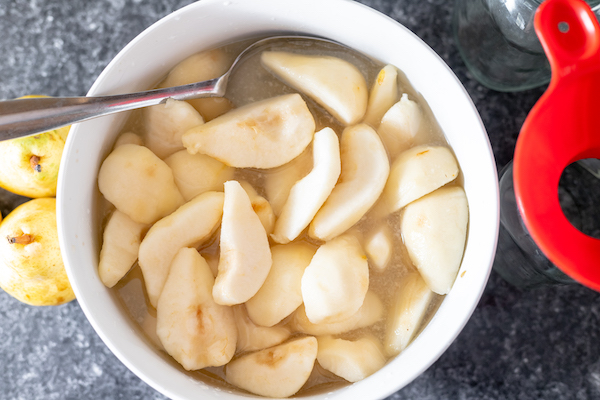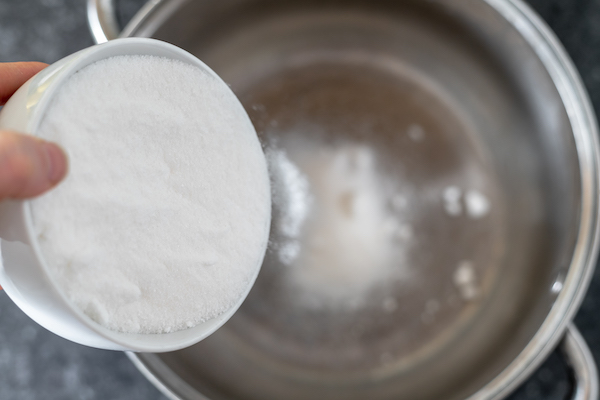Canning pears is a great way to preserve this delicious fruit and enjoy it all year round. However, many people wonder whether it is necessary to peel pears before canning. This article will explore the pros and cons of canning pears with skins on, providing you with the information you need to make an informed decision.
Benefits of Canning Pears with Skins On
There are several benefits to canning pears with skins on:
- Preserves nutrients: The skin of pears is a rich source of vitamins, minerals, and fiber. Canning pears with skins on allows you to retain these nutrients, making your canned pears a more nutritious option.
- Enhances flavor: The skin of pears contains compounds that contribute to the fruit’s flavor. Canning pears with skins on can result in a more flavorful product.
- Reduces prep time: Peeling pears can be a time-consuming task. Canning pears with skins on saves you time and effort.
Drawbacks of Canning Pears with Skins On
There are also some drawbacks to canning pears with skins on:
- Tough texture: The skin of pears can become tough when canned. This can be undesirable, especially if you prefer pears with a softer texture.
- Discoloration: The skin of pears can discolor when canned, resulting in an off-color product. This may not affect the taste of the pears, but it can be visually unappealing.
Safety Considerations
Canning pears with skins on is safe, provided that you follow proper canning procedures. This includes using clean jars and lids, processing the pears for the correct amount of time, and storing the canned pears in a cool, dark place.
Personal Preference
Ultimately, the decision of whether or not to peel pears before canning is a matter of personal preference. If you prefer the taste and texture of canned pears with skins on, then go ahead and can them that way. However, if you prefer a softer texture and a more uniform appearance, then you may want to peel the pears before canning.
Tips for Canning Pears with Skins On
If you decide to can pears with skins on, here are a few tips:
- Choose ripe pears: Ripe pears will have a sweeter flavor and a softer texture.
- Wash the pears thoroughly: This will remove any dirt or bacteria from the pears.
- Remove the stems and blossom ends: These parts of the pear can be tough and bitter.
- Cut the pears into desired size: You can cut the pears into halves, quarters, or slices.
- Pack the pears into jars: Pack the pears tightly into clean jars, leaving about 1/2 inch of headspace at the top of each jar.
- Add boiling water: Fill the jars with boiling water, leaving about 1/2 inch of headspace at the top of each jar.
- Process the pears: Process the pears in a boiling water bath for the recommended amount of time. This will vary depending on the size of the jars and the altitude at which you are canning.
- Store the pears: Store the canned pears in a cool, dark place for up to one year.
Canning pears with skins on is a safe and convenient way to preserve this delicious fruit. While there are some drawbacks to canning pears with skins on, such as a tougher texture and potential discoloration, the benefits of canning pears with skins on, such as preserving nutrients and enhancing flavor, may outweigh the drawbacks for some people. Ultimately, the decision of whether or not to peel pears before canning is a matter of personal preference.
How to keep pears from turning brown
As I mentioned earlier, a big bowl of lemon water is a great way to prevent the browning and softening of your waiting pears.

You can also use citric acid or stay fresh, but the simplest method for me is to always have lemon juice on hand.
Let the prepared pears to settle in a quart of cool water with about 1/4 cup of lemon juice while you peel and slice them.
How to make a light syrup for canning pears
Confession time: I’m not a huge fanning of adding sugar. I don’t want jars of sugar to start piling up on my pantry shelves.
But when you can fruit, you need something.
Can you can pears in water? Technically, yes. However, it produces a rather bland and mushy fruit (this also applies to peaches). Remember that the fruit’s natural sweetness leaches into the water surrounding it during the canning process.
Is using sugar a requirement as a result? Both yes and no.
Half a cup of sugar dissolved in one quart of water yields light syrup.
Fruit juice is another option; it’s a more natural sugar. Pear juice itself is a popular option, as is white grape and pineapple juice. This is a pretty common practice in commercial canneries, actually. There are many options available on the canned goods shelves of grocery stores, such as “fruit juice,” “light syrup,” and “heavy syrup.” To make the flavor of the fruit juice milder, you might want to dilute it with water.
Another option for making syrup is to use maple syrup. You could use 3/4 cup of syrup for every quart of water in this. I personally don’t like this because, even though I adore maple syrup’s flavor, I don’t like it thinned out. It’s not a great option for us, particularly now that we live in a place where maple syrup is practically worth its weight in gold.
Here’s how to make cane sugar, which is what I usually choose to use:
In a large pot, mix 1 1/2 cups sugar with 5 quarts water, and heat until the sugar is dissolved.

Canning Pears Made Simple! (Bonus: Easiest Way To Peel Pears)
FAQ
Do you have to peel pears?
What is the best way to prepare pears for canning?
Can you cold pack pears for canning?
How do you keep pears from turning brown when canning?
Do you need to cook pears before canning?
You may be wondering if you need to cook pears before canning. This is considered hot-packing pears, when you boil them slightly before adding them to your canning jars. You do not need to cook pears before canning, you can use a raw-pack method, but here’s why I recommend using a hot pack method.
How do apples and pears ripen naturally?
Apples and pears ripen over time, out of the cold of the refrigerator. Wrapping the pears in paper can help slow the process down.
Should pears be ripe for canning?
Yes, pears for canning should be ripe, but not overly ripe (mushy). Pears are the rare fruit that can be picked green and still taste wonderful when is ripened off the tree. It is common to pick pears green but wait until they are ripe to can them. If your pears are green, let them set on the counter for a few days at least.
Can pears be canned?
You may can pears in just water, unsweetened apple juice, or light to medium syrup (which is a mixture of sugar and water in different ratios). You must use the hot pack method if you choose to can fruit with just water. I prefer to use a light syrup, but if you want, canning pears can be done with honey instead of sugar.
